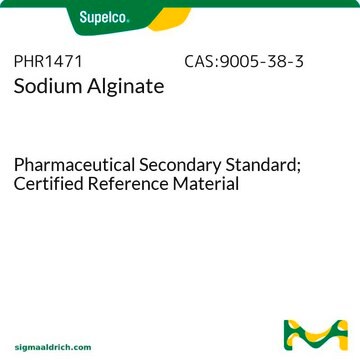A0682
Ácido algínico sodium salt from brown algae
BioReagent, suitable for plant cell culture, low viscosity, powder
Sinónimos:
Algin, Alginato de sodio
About This Item
Productos recomendados
biological source
algae (brown)
product line
BioReagent
form
powder
technique(s)
cell culture | plant: suitable
viscosity
4-12 cP, 1 % in H2O(25 °C)(lit.)
application(s)
agriculture
InChI
1S/C6H10O7.Na/c7-1-2(8)4(5(10)11)13-6(12)3(1)9;/h1-4,6-9,12H,(H,10,11);/q;+1/p-1/t1-,2-,3-,4?,6+;/m0./s1
InChI key
MSXHSNHNTORCAW-MPGIDXPLSA-M
¿Está buscando productos similares? Visita Guía de comparación de productos
Application
Other Notes
Storage Class
11 - Combustible Solids
wgk_germany
WGK 1
flash_point_f
Not applicable
flash_point_c
Not applicable
ppe
Eyeshields, Gloves, type N95 (US)
Certificados de análisis (COA)
Busque Certificados de análisis (COA) introduciendo el número de lote del producto. Los números de lote se encuentran en la etiqueta del producto después de las palabras «Lot» o «Batch»
¿Ya tiene este producto?
Encuentre la documentación para los productos que ha comprado recientemente en la Biblioteca de documentos.
Los clientes también vieron
Nuestro equipo de científicos tiene experiencia en todas las áreas de investigación: Ciencias de la vida, Ciencia de los materiales, Síntesis química, Cromatografía, Analítica y muchas otras.
Póngase en contacto con el Servicio técnico






